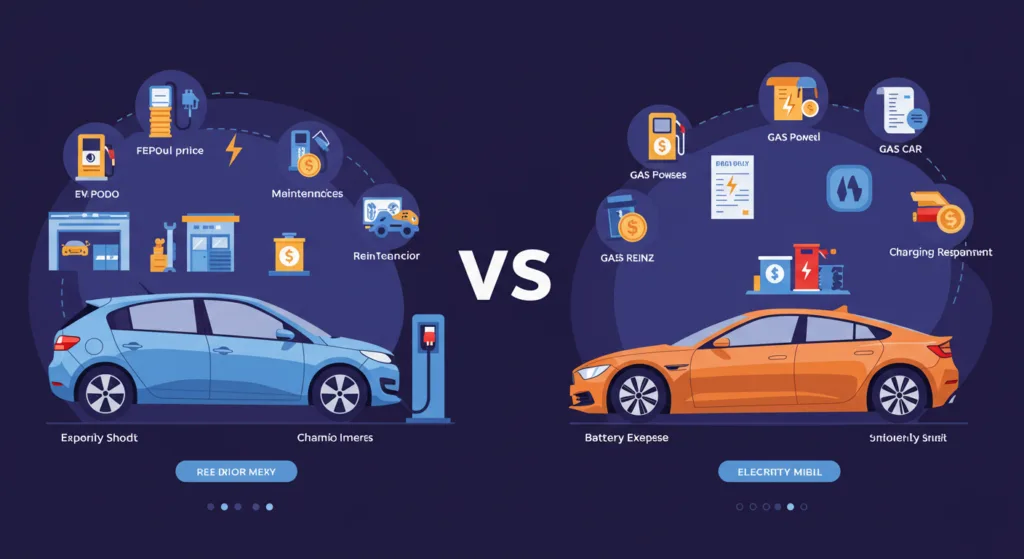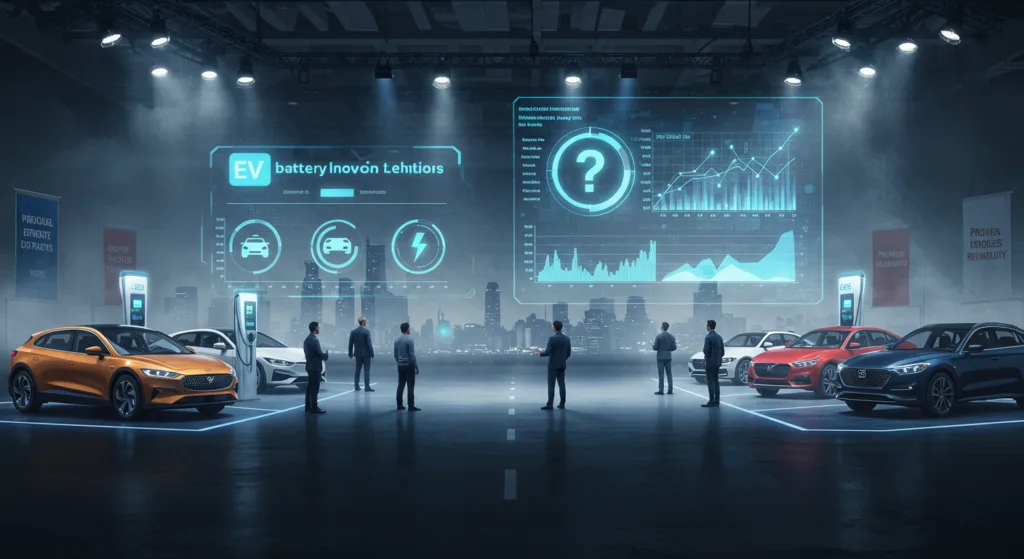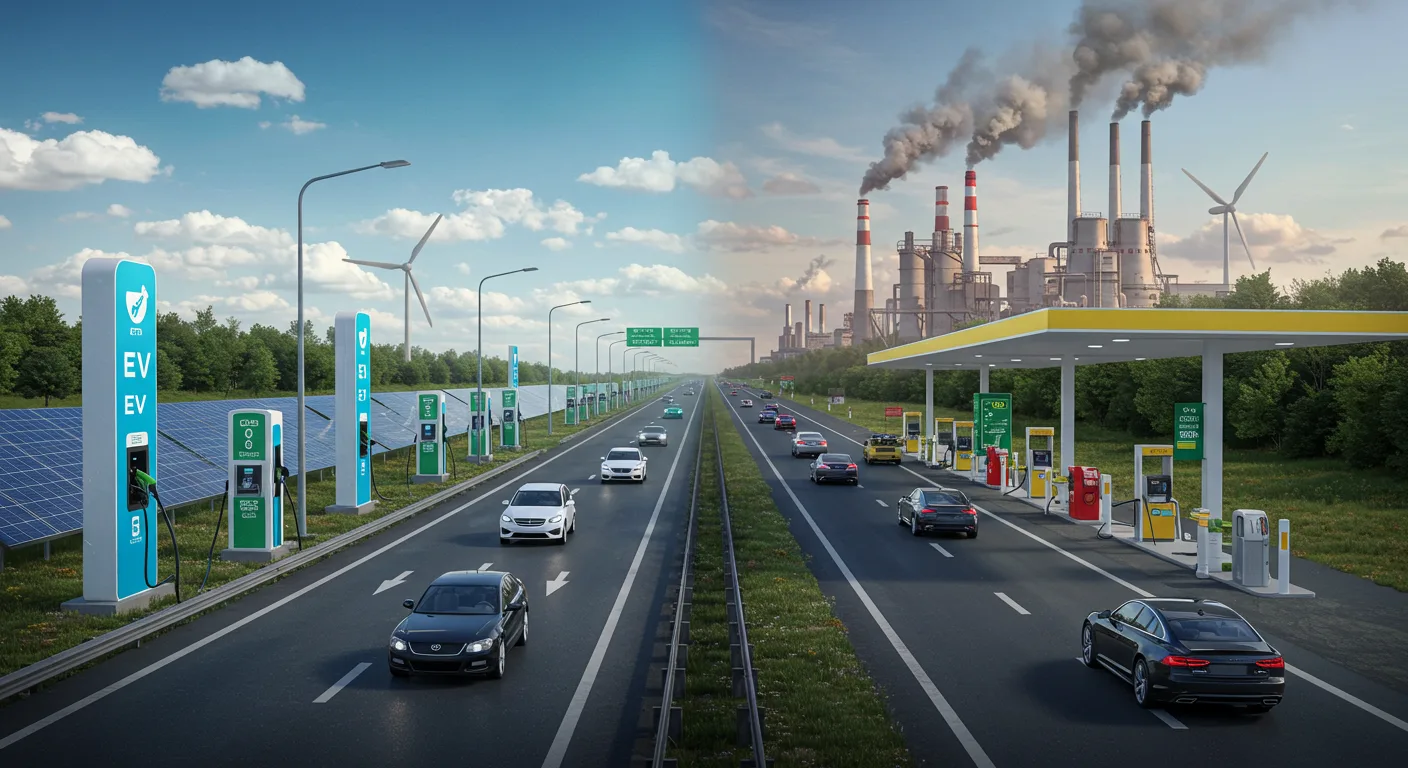Are Electric Cars Really More Cost-Effective Than Gas Cars?

With the rise of electric vehicles ( EV ), many drivers are questioning whether making the switch truly saves money in the long run. While EVs are marketed as a cost-effective and environmentally friendly alternative to gas-powered cars, real-world ownership costs tell a more complex story. Below, we break down the hidden expenses, compare total cost of ownership, and explore how resale value factors into this debate.
The Hidden Costs of EV Ownership: Maintenance, Charging, and Battery Replacements
One of the biggest misconceptions about EVs is that they require little to no maintenance. While it’s true that EVs have fewer moving parts than internal combustion engine (ICE) vehicles, they come with their own set of costs that many drivers overlook.
1. Battery Replacement Costs
- The battery is the most expensive component in an EV. On average, replacement costs range between $5,000 and $15,000, depending on the model and battery size.
- Tesla’s Model 3 battery replacement can cost around $13,000, while a Nissan Leaf battery replacement ranges from $6,500 to $9,500.
- Although most batteries last 8-15 years, degradation can begin sooner, especially in extreme climates.
2. Charging Costs vs. Gas Costs
Many believe EV charging is significantly cheaper than refueling a gas car, but the reality depends on where and how you charge:
- Home charging: Costs around $0.13 – $0.20 per kWh in the U.S., meaning a full charge for a Tesla Model Y (75 kWh battery) costs approximately $10 – $15.
- Public fast chargers: Some networks charge $0.30 – $0.50 per kWh, making a full charge $20 – $37, rivaling gas prices.
- Gas comparison: A gas car averaging 30 MPG at $3.50 per gallon costs $35 to fill a 10-gallon tank, but can drive 300 miles, similar to an EV’s full charge range.
3. Maintenance Costs Aren’t Always Lower
EVs have fewer mechanical parts, reducing the need for oil changes and transmission repairs. However, they require specialized servicing:
- Tire replacements are more frequent due to the added weight of EVs.
- Brake system maintenance is less frequent due to regenerative braking but can still be costly.
- Battery cooling system repairs can be expensive, with some repairs exceeding $2,000.
Gas vs. Electric: Which One Actually Saves You More Money Over Time?
Total cost of ownership (TCO) is a critical factor in the EV vs. gas debate. When calculating savings, it’s essential to consider purchase price, incentives, fuel costs, and maintenance over time.
1. Upfront Costs & Incentives
- The average price of an EV in the U.S. in 2024 is $53,000, while gas-powered cars average around $47,000.
- Federal and state incentives can reduce EV costs, with the U.S. federal tax credit offering up to $7,500 for eligible models.
- However, some incentives are phasing out for automakers that have sold over 200,000 EVs, making future cost savings uncertain.
2. Cost Per Mile Over Five Years
A cost-per-mile comparison based on 15,000 miles per year:
- EVs: Assuming $0.15 per kWh, an EV costs $600 – $900 per year to charge.
- Gas Cars: At $3.50 per gallon and 30 MPG, gas costs $1,750 per year.
- Over five years, EVs can save $4,000 – $6,000 in fuel, but this doesn’t always offset higher upfront costs.
3. Depreciation & Insurance Costs
- EV insurance is typically 15-25% more expensive than for gas vehicles due to costly repairs.
- EVs depreciate at different rates:
- Tesla Model 3 retains 67% of its value after 3 years.
- Nissan Leaf loses 50%+ of its value within 3 years.
The Resale Value Dilemma: Why Some Drivers Are Losing Money on EVs
Resale value plays a crucial role in the long-term cost-effectiveness of any vehicle. While some EVs hold their value well, others face rapid depreciation due to battery concerns, outdated technology, and changing incentives.
1. Battery Degradation Affects Resale Prices
- EV buyers worry about battery degradation, which lowers resale value.
- A used EV with 80% battery capacity is less attractive than a new one, reducing its market demand.
- Tesla’s advanced battery management system retains 90% capacity after 200,000 miles, while older models like the Nissan Leaf degrade faster.
2. EV Market Saturation Is Driving Prices Down
- The used EV market is expanding, increasing supply and pushing prices down.
- The availability of cheaper new EVs makes buying a used one less appealing.
- Gas cars, on the other hand, remain stable in demand, ensuring better resale value for many models.
3. Incentive Impact on Used EV Prices
- New EV buyers often receive tax credits, but used EV buyers do not, making used models less attractive.
- A Tesla Model Y purchased new for $50,000 may sell for $35,000 after 3 years, while a Toyota Camry bought for $30,000 may still retain $22,000 in value.
With these financial considerations, the decision to switch to an EV or stick with gas cars depends on individual driving habits, local electricity costs, incentives, and long-term ownership plans.
💡 EV vs. Gas Car Tip:
“Before switching to an EV, calculate not just fuel savings but also battery replacement costs, charging expenses, and resale value to ensure it truly fits your lifestyle and budget.”
What Are the Biggest Challenges of Owning an Electric Car?

Electric vehicles (EVs) are often praised for their environmental benefits and lower fuel costs, but many owners face significant challenges that impact their daily driving experience. From charging infrastructure limitations to performance issues in cold weather, EVs are not without their drawbacks. Here’s a deep dive into some of the biggest pain points that are leading some drivers to reconsider their switch to electric.
Charging Infrastructure Woes: Range Anxiety and Limited Fast Chargers
One of the most common concerns among EV owners is range anxiety—the fear of running out of charge before reaching a charging station. While charging networks are expanding, they still lag behind the convenience of gas stations.
1. The Availability Problem: Not Enough Chargers
- As of early 2024, the U.S. has around 165,000 public charging ports, compared to over 145,000 gas stations, many with multiple pumps.
- In rural areas, charging stations are still scarce, forcing EV drivers to plan routes carefully to avoid being stranded.
- Tesla’s Supercharger network is the most reliable, but non-Tesla drivers face inconsistent access and longer wait times.
2. Slow Expansion of Fast-Charging Networks
- Level 1 chargers (standard outlets) take 12-24 hours to fully charge a car.
- Level 2 chargers (home and public stations) take 4-10 hours for a full charge.
- Fast chargers (DC fast charging) can charge a battery to 80% in 20-45 minutes, but they are limited in availability.
- Many EV owners experience broken or occupied chargers, making charging less reliable than fueling a gas car.
3. Home Charging Isn’t Always an Option
- Apartment dwellers and people without garages often lack access to home chargers.
- Installing a Level 2 home charger costs $1,000 – $2,500, adding to the total cost of EV ownership.
- Some states and utility companies offer rebates, but installation delays are common.
Cold Weather and EVs: Why Some Drivers Are Struggling in Winter
Cold temperatures can significantly impact EV battery performance, reducing driving range and increasing charging times. For drivers in northern climates, this has become a major issue.
1. Reduced Range in Cold Weather
- EVs lose between 20-40% of their range in freezing temperatures.
- A Tesla Model Y, which has a normal range of 330 miles, can drop to 200-250 miles in winter conditions.
- The Hyundai Kona EV, rated at 258 miles per charge, can see range reductions to 150-180 miles in extreme cold.
2. Heating Drains the Battery
Unlike gas cars, which use engine heat for cabin warmth, EVs rely on electric resistance heating or heat pumps, which consume a significant amount of battery power.
- Turning on the heater in an EV can reduce range by 10-20%.
- Some newer EVs come with heat pumps (e.g., Tesla Model Y, Kia EV6) to improve efficiency, but older models suffer more range loss.
3. Slower Charging in Cold Temperatures
- Cold weather slows down lithium-ion battery chemistry, increasing charging time.
- A DC fast charger that normally takes 30 minutes can take over an hour in sub-zero temperatures.
- Some charging stations struggle in extreme cold, leading to unexpected charging failures.
The Long Charging Wait: How EV Convenience Compares to Gas Cars
Even with fast-charging technology, charging an EV still takes significantly longer than refueling a gas vehicle. This is a major drawback for drivers who prioritize convenience and long-distance travel.
1. Refueling Time: Gas vs. EV Charging
- Gas car: A full tank takes 3-5 minutes at any gas station.
- EVs (fast charging): A 10-80% charge takes 20-45 minutes, depending on the battery size and charger speed.
- EVs (home charging): Charging from 10% to 100% can take 6-12 hours, depending on the charger type.
2. Road Trip Challenges
Long-distance travel in an EV requires more planning and longer stops than a gas-powered car.
- A 500-mile trip in a gas car requires one 5-minute fuel stop.
- The same trip in an EV may require two 30-45 minute charging stops, adding 1-1.5 hours to total travel time.
- Charging station availability varies by region, with fewer options on rural highways.
3. Charger Availability and Queues
As more EVs hit the road, charger congestion is becoming an issue, especially at busy locations.
- Tesla Superchargers sometimes have long wait times during peak hours.
- Non-Tesla EVs rely on third-party charging networks, which may have outdated or broken chargers.
- Unlike gas stations, which have multiple pumps, many EV charging stations only have 2-6 chargers, leading to delays.
These challenges highlight the current limitations of EV technology and infrastructure, making gas cars still a practical choice for many drivers
📢 Quote to Consider:
“The electric vehicle revolution is not just about innovation; it’s about infrastructure, affordability, and practicality.” — Industry Analyst
Is the Future of EVs Uncertain? Experts Weigh In

As electric vehicle (EV) adoption rises, many wonder whether this transition is truly sustainable or just a temporary trend. Governments worldwide are pushing for EV expansion, but real-world challenges, consumer demand shifts, and ongoing environmental debates are reshaping the market. Below, we explore the future of EVs from multiple perspectives.
Government Incentives vs. Real-World Adoption: Is EV Growth Sustainable?
The EV boom has been largely fueled by government incentives, tax credits, and emissions regulations, but the long-term sustainability of this growth is uncertain. While EV sales have increased, there are signs that consumer adoption is not happening as fast as anticipated.
1. The Role of Government Incentives in EV Sales
- In the U.S., the federal tax credit offers up to $7,500 for eligible EVs, with additional state-level rebates in places like California, where buyers can get up to $2,000 in extra incentives.
- The European Union provides subsidies for EV purchases, with countries like Germany offering €4,500 – €6,750 per EV purchase.
- China, the world’s largest EV market, extends substantial subsidies to EV manufacturers to keep production costs down.
Despite these incentives, many governments are phasing out or reducing subsidies:
- Germany ended most EV purchase incentives in 2024, causing a sharp decline in EV sales.
- Some U.S. tax credits will expire after 2032, depending on legislative changes.
- Norway, a leader in EV adoption, is reconsidering its aggressive subsidies as EVs now dominate new car sales.
2. Are Consumers Ready for an All-EV Future?
- A 2023 Cox Automotive study found that only 38% of U.S. consumers are “seriously considering” an EV for their next vehicle, down from 51% in 2021.
- High upfront costs and concerns about charging infrastructure are major barriers for potential buyers.
- EV market share in the U.S. was 7.6% in 2023, far from the 50% target set for 2030.
3. Automakers Are Adjusting Strategies
- Ford delayed its $12 billion investment in EVs due to slowing demand.
- GM scaled back EV production targets, citing a lack of consumer readiness.
- Toyota and Honda continue investing in hybrid vehicles, seeing them as a more realistic bridge before full EV adoption.
If EV incentives disappear and demand remains inconsistent, will automakers and consumers still push forward with electrification?
Are Gas Cars Making a Comeback? Market Trends and Consumer Demand
With rising concerns over EV limitations, some consumers and automakers are reconsidering gas-powered vehicles. While EV adoption is increasing, gas cars are still dominant in many markets.
1. Gas Car Sales Remain Strong
- In 2023, gas-powered vehicles still made up 86% of all car sales worldwide.
- The U.S. market saw a 10% increase in hybrid and plug-in hybrid (PHEV) sales, suggesting buyers prefer a middle ground rather than full electrification.
- In Europe, demand for gas cars is rebounding due to high electricity prices and reduced EV subsidies.
2. The Rise of Plug-In Hybrids (PHEVs)
Many consumers are turning to plug-in hybrid electric vehicles (PHEVs) instead of fully electric cars.
- Toyota, BMW, and Honda are expanding their PHEV offerings as demand grows.
- A PHEV allows 30-50 miles of electric range while having a gas engine for long trips, reducing range anxiety.
- In 2023, PHEV sales increased by 45% in the U.S., outpacing full EV growth in some regions.
3. Gas Prices and Consumer Preferences
- Despite fluctuations, gas prices remain competitive, making gas cars more appealing in areas with expensive electricity.
- Long road trips and rural driving conditions still favor gas vehicles due to the limited availability of fast chargers.
As a result, many drivers are choosing hybrids or sticking with gas cars, showing that the full EV transition may take longer than expected.
The Environmental Debate: Are EVs Truly Greener Than Gas Cars?
A major selling point of EVs is their reduced carbon footprint, but the reality is more complex. The environmental impact of EVs depends on battery production, energy sources, and recycling efforts.
1. Manufacturing an EV Has a Higher Carbon Footprint
- Producing an EV, especially its lithium-ion battery, generates 60-70% more CO₂ emissions than making a gas car.
- Lithium, cobalt, and nickel mining for EV batteries causes significant environmental damage and ethical concerns.
- However, once on the road, an EV’s lower emissions compensate for this initial impact over time.
2. EV Emissions Depend on Electricity Sources
- In countries using coal-powered electricity, EVs produce only 20-30% fewer emissions than gas cars.
- In areas with renewable energy grids (like Norway or California), EVs can reduce emissions by 60-80%.
- A study by the International Energy Agency (IEA) found that an EV in a coal-heavy region takes 5-7 years to break even in emissions compared to a gas car.
3. Battery Recycling and Environmental Concerns
- The lifecycle of an EV battery remains a challenge.
- Less than 5% of lithium-ion batteries are fully recycled today, raising concerns about long-term waste.
- Companies like Tesla and Redwood Materials are working on battery recycling solutions, but large-scale adoption is still in progress.
4. Gas Cars Are Becoming Cleaner
- Modern gas engines are more fuel-efficient than ever, reducing emissions.
- Synthetic fuels (e-fuels) and hydrogen-powered combustion engines are being developed as alternatives to full electrification.
- Some experts argue that a mix of gas, hybrids, and EVs is a more sustainable approach than forcing full EV adoption.
With governments adjusting policies, automakers rethinking strategies, and consumers showing mixed demand, the future of EVs remains uncertain. While the transition to electric is progressing, hybrids and gas cars are far from obsolete—suggesting that the road to a fully electric future may take longer than expected.
Electric vehicles offer many advantages, but challenges like charging infrastructure, cold weather performance, resale value, and long charging times make the transition more complicated than expected. While EV adoption continues to grow, many drivers are reconsidering hybrids or even switching back to gas cars due to these hurdles. The future of EVs depends on advancements in battery technology, government policies, and real-world consumer demand.
⏳ Reminder for Drivers:
🚗 “EVs are evolving, but gas cars aren’t disappearing overnight. Stay informed about technological advancements, government policies, and real-world challenges before making your decision!” ⚡
🚗 What do you think? Are EVs the future, or will gas cars stick around longer than expected? Share this article on social media and join the debate! 🔋⚡



